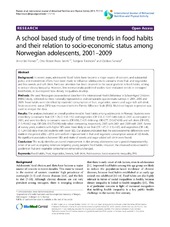| dc.description.abstract | Background: In recent years, adolescents’ food habits have become a major source of concern, and substantial policy and intervention efforts have been made to influence adolescents to consume more fruit and vegetables and less sweets and soft drink. Particular attention has been devoted to the social gradient in food habits, aiming to reduce dietary inequality. However, few internationally published studies have evaluated trends in teenagers’ food habits, or investigated how dietary inequalities develop. Methods: We used Norwegian cross-sectional data from the international Health Behaviour in School-Aged Children (HBSC) study, collected via three nationally representative and comparable questionnaire surveys in 2001, 2005 and 2009. Food habits were identified by students’ consumption of fruit, vegetables, sweets and sugar rich soft drink. Socio-economic status (SES) was measured with the Family Affluence Scale (FAS). Multilevel logistic regression was used to analyze the data. Results: The analyses indicated an overall positive trend in food habits among adolescents in Norway. Students were more likely to consume fruit (OR 1.76, CI 1.61-1.92) and vegetables (OR 1.51, CI 1.37-1.66) daily in 2005 as compared to 2001, and were less likely to consume sweets (OR 0.58, CI 0.51-0.66 resp. OR 0.77, CI 0.67-0.90) and soft drink (OR 0.55, CI 0.49-0.62 resp. OR 0.84, CI 0.73-0.96) daily when comparing, respectively, 2005 with 2001 and 2009 with 2005. Across all survey years, students with higher SES were more likely to eat fruit (OR 1.47, CI 1.32-1.65) and vegetables (OR 1.40, CI 1.24-1.58) daily than did students with lower SES. Our analyses indicated that the socio-economic differences were stable in the period 2002 - 2010, with uniform improvement in fruit and vegetable consumption across all SES levels. No significant associations between SES and intake of sweets and sugar-added soft drink were found. Conclusion: The study identifies an overall improvement in diet among adolescents over a period characterized by onset of as well as ongoing initiatives targeting young people’s food habits. However, the observed socio-economic gradient in fruit and vegetable consumption remained unchanged. | en_US |

